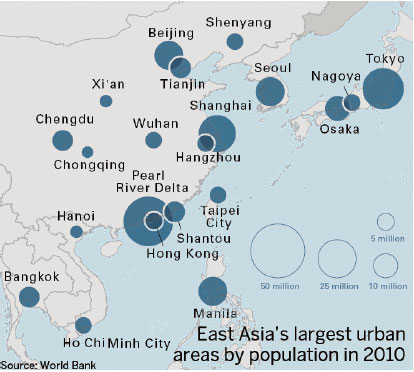China's urbanization drive will create larger clusters of cities, in terms of economic power as well as size and population, according to experts.
Chinese policymakers favor the development of clusters of relatively large cities, rather than megacities.
According to a World Bank report on Monday, the Pearl River Delta in South China has overtaken Tokyo as the world's largest urban area in terms of population and land mass.
Feng Kui, a researcher at the China Center for Urban Development, said the challenge remains for city clusters, including that in the Pearl River Delta, to build internal integration and the capability for sustainable growth.
The center is affiliated with the National Development and Reform Commission.
According to the World Bank report on urbanization in East Asia, the Pearl River Delta, which includes Guangzhou, Shenzhen, Foshan and Dongguan, has 42 million residents, a population larger than that in Canada or Argentina.
The report, based on data including those gathered through satellite imagery and geospatial mapping, said about 36 percent of the population in East Asia lived in urban areas as of 2010, up from 29 percent at the start of the decade.
Feng said the National Development and Reform Commission is carrying out a plan to develop five national-level urban clusters.
These are in the Yangtze River Delta, the Pearl River Delta, the Beijing-Tianjin-Hebei area, the middle reaches of the Yangtze River and the Chengdu-Chongqing area, he said.
Zhai Zhenwu, dean of Renmin University of China's School of Sociology and Demography, said that of China's 1.3 billion-plus population, 53 percent are fully fledged urban residents.
There is a floating population of about 250 million migrant workers and their families, and this number increases by about 10 million annually.
The end result of the country's urbanization drive could see nearly 1.2 billion people living in cities, Zhai said.
According to a study by Li Xia, a professor in geography and urban planning at Sun Yat-Sen University in Guangzhou, in some ways environmental quality in the Pearl River Delta city cluster is declining much more rapidly than in developed countries.
The World Bank report said China's urbanization dominates East Asia, with 600 of the region's 869 urban areas located in the country, which has more than two-thirds of East Asia's total urban land.
World Bank urban development expert Abhas Jha said he hopes the report will push policymakers to shift from a "car-centric" to a "people-centric" strategy in growing cities to address challenges such as traffic congestion.
"Getting urban form, density and administrative coordination right will be essential to helping end extreme poverty and boost shared prosperity," Jha was quoted as saying by Xinhua News Agency.
Xinhua contributed to this story.
qiuquanlin@chinadaily.com.cn

